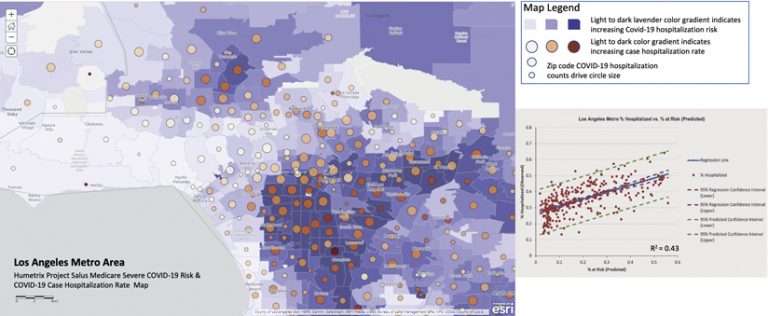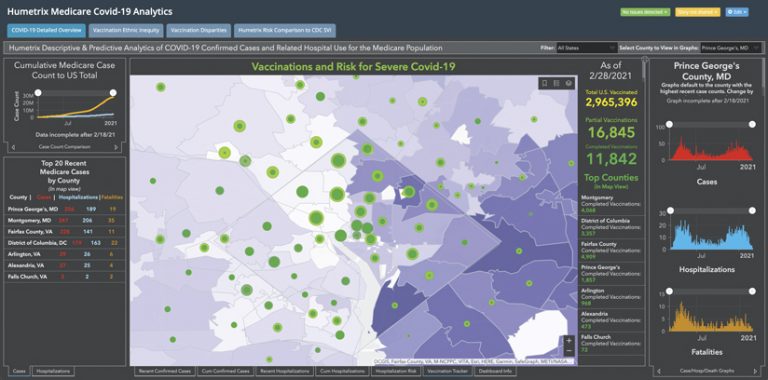When the COVID-19 pandemic took the world by storm, the United States military quickly mobilized to move personal protective equipment (PPE), hospital beds, and other supplies to facilities in need and send extra staffing to overwhelmed medical centers. As the country now contends with highly contagious variants of the virus while engaging in the biggest vaccination campaign in its history, the US military is still at work helping to distribute vaccines and administer shots.
To optimize this critical mission, the military needed a clear vision of where its assets and resources would be most useful—namely, in places where people were most susceptible to developing severe cases of the disease and, later, where vaccinations were lagging. The best way to do this was to build an operational dashboard that mapped COVID-19 cases, predicted where the pandemic was heading, and allowed the military to keep track of its mobilization efforts. This was especially important at the outset of the vaccination program to ensure that priority was given to the most at-risk populations.

To launch the operation, the Joint Artificial Intelligence Center (JAIC) at the United States Department of Defense (DoD) assembled leading technology companies, including Amazon, Microsoft, IBM, Dell, and Esri, under Project Salus. (Salus is the Roman goddess of health and well-being.) Digital health innovation company Humetrix was brought in to analyze data about older individuals and others who are most at risk for severe COVID-19 and to build a dashboard to present the results in an easy-to-interpret visual format. But getting that data was going to be a challenge.
A Novel Way to Track Infections
In March 2020, when Project Salus got under way, it was difficult to understand the spread of COVID-19, let alone forecast where spikes in infections would happen next, because tests for the disease were not yet widely available. Time was of the essence, however, as more individuals were getting infected and hospitalized each day—particularly older individuals and people with other serious health problems.
To fill the gap caused by limited COVID-19 testing and reporting, the health mission chief for JAIC, US Navy captain Dr. Hassan Tetteh, had an idea. A thoracic surgeon and informatics specialist who was caring for COVID-19 patients, Tetteh realized that the diagnosis and other medical codes that are included on the Medicare claims that health-care providers submit to Medicare for payment could help track where people were contracting the disease.
Medicare provides health-care coverage to most US citizens and permanent residents over the age of 65, as well as for people with disabilities and end-stage kidney disease. So data from Medicare claims, broken down into the diagnostic codes that indicate diseases such as diabetes, chronic kidney disease, chronic lung disease, and now COVID-19, would provide essential information about a population that’s at high risk of experiencing severe COVID-19 symptoms.
“The military has always led with medical advances, beginning with General George Washington’s Continental Army and the first mass military inoculation campaign to address the deadly smallpox disease and continuing with the US Army’s pioneering innovation in blood banking to save lives from the Civil War to the present,” said Tetteh. “Today, technology, data, and mapping are more advanced than ever, and the DoD Joint Artificial Intelligence Center has led an important initiative through Project Salus to help support the nation’s COVID-19 response.”
Mapping Risk Across the Nation, Down to the Local Level
By early April 2020, Project Salus had received tens of millions of deidentified Medicare claim records from the Centers for Medicare & Medicaid Services (CMS) in a secure government enclave. This database of Medicare claims, which had all personal identification information removed, was designed to capture COVID-19 diagnoses in a large, Medicare-covered population that was geographically distributed across the United States.
The Humetrix team processed and analyzed this data using its analytics platform, which employs various algorithms and relies on a classic statistical analysis method called logistic regression to identify risk factors for different disease outcomes, including COVID-19. With help from Esri, Humetrix used the DoD’s ArcGIS Enterprise system to map the results of its analyses and display them on a dashboard created with ArcGIS Dashboards.
The dashboard showed, at the county and ZIP code levels, confirmed COVID-19 cases among Medicare beneficiaries, as well as areas where the population was more likely to be hospitalized and die from the disease. The military was then able to use this dashboard, which was updated on a weekly basis, to carry out its pandemic support mission.
Validated Data Helps Transform Vaccination Campaigns
Between April 2020 and July 2021, the number of Medicare beneficiaries in the Project Salus database grew from 5 million to 20 million. By August 2021, the cohort of Medicare patients that Humetrix was observing included more than 2.7 million COVID-19 cases and accounted for about 50 percent of all the COVID-19 hospitalizations (986,000 out of about 1,981,300) and deaths (329,000 out of about 613,700) in the United States.

The predictive risk map that Humetrix had developed using this information was later validated by observed COVID-19 hospitalization rates throughout the United States. So, reassuringly, Humetrix and the rest of the Project Salus team had gotten their predictions right.
Once COVID-19 vaccines became available, Medicare claims began including codes that showed when patients had received their shots. Humetrix was able to overlay this vaccination data on the COVID-19 risk map it had already built to see where vaccination campaigns needed to be ramped up.
The results showed a nationwide pattern of inadequate prioritization. In general, areas with low vaccination rates coincided with populations that were at high risk of developing severe COVID-19. Presenting this information on the dashboard helped the military support local health departments in opening more vaccine clinics and instituting targeted outreach.
Continued Monitoring of COVID-19 and Vaccine Variables
Now that the COVID-19 vaccination program has reached the majority of American adults, Humetrix is currently tracking the effectiveness of the vaccines.
According to Humetrix, the deidentified Medicare claims are showing that, while breakthrough cases in fully vaccinated individuals are happening—likely caused by some waning vaccine immunity and the prevalence of the more contagious Delta variant—the vaccines remain highly effective against severe disease. The number of breakthrough cases being recorded in the cohort amounts to only 2.6 percent cumulatively, according to Humetrix as of mid-August 2021. Of those breakthrough cases, 20 percent were hospitalized compared to 32 percent of the COVID-19 cases in the cohort before vaccinations began. (Keep in mind that Humetrix is studying a specific and high-risk population, so more breakthrough cases are severe compared to the population at large.) The vaccines are indeed preventing most at-risk people from developing severe COVID-19 that requires hospitalization or results in death.
Because Humetrix has access to Medicare beneficiaries’ deidentified prior medical histories, the company’s analytics can also pinpoint when individuals experience adverse events following vaccination and use the diagnosis codes to see if those ailments are new or were present before. The company is providing its data to the Centers for Disease Control and Prevention (CDC) and the US Food and Drug Administration (FDA) for further study.
From January to June 2021, Humetrix recorded a 90 percent reduction in daily COVID-19 cases in its Medicare cohort, thanks to the massive vaccination campaign that got under way and that the military helped execute. But the fight isn’t over. Using advanced analytics and GIS technology, Humetrix will continue to track the pandemic and deliver critical insight to federal government stakeholders until the United States—and the world—can get this public health crisis under control.


